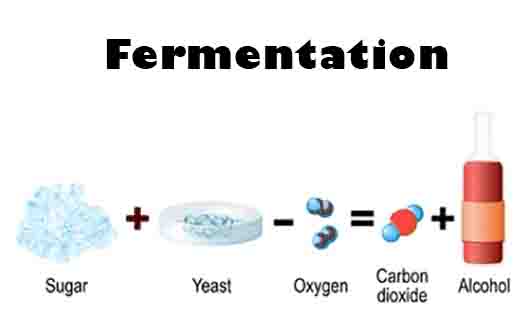Fermentation Definition
In the absence of oxygen or electron transport chains, fermentation refers to the conversion of organic molecules (normally glucose) into acids, gases, or alcohol. Adenosine triphosphate (ATP) is generated in glycolysis via fermentation pathways that regenerate the coenzyme nicotinamide adenine dinucleotide (NAD+).
Through glycolysis, fermentation yields only two molecules of ATP per glucose molecule, while aerobic respiration generates as many as 32 molecules of ATP per glucose molecule.
The study of fermentation and its practical applications is known as zymology. French chemist Louis Pasteur demonstrated in 1856 that fermentation is caused by yeast. Bacteria and fungi that require an oxygen-free environment to survive (called obligate anaerobes), as well as in muscle cells when oxygen is in short supply (such as during strenuous exercise), undergo fermentation.
It is important to understand the importance of fermentation in the food and beverage industries since it converts sugars into ethanol for alcoholic beverages, releases CO2 when yeast is used to leaven bread, and produces organic acids that preserve and flavor vegetables and dairy products.
Function of Fermentation
Glycolysis requires NADH to be converted back into the coenzyme NAD+ through fermentation. The fermentation process produces carbon dioxide and ethanol (ethanol fermentation) or lactate (lactic acid fermentation) when an organic electron acceptor (such as pyruvate or acetaldehyde) reacts with NADH to form NAD+.
Types of Fermentation
Fermentation differs according to the end products formed from pyruvate or its derivatives. Humans use two fermentation techniques to produce commercial foods: ethanol fermentation (used in beer and bread) and lactic acid fermentation (used to flavor and preserve dairy and vegetables).
Ethanol Fermentation
In ethanol fermentation, pyruvate produced by glycolysis is converted into ethanol and carbon dioxide in two steps. A two-carbon compound called acetaldehyde is formed by the release of carbon dioxide by the pyruvate. NADH then reduces acetaldehyde to ethanol, regenerating NAD+ for glycolysis.
In total, one molecule of glucose is converted into two molecules of carbon dioxide and two molecules of ethanol.
As a unicellular fungus, yeast is typically used for ethanol fermentation.
Lactic Acid Fermentation
Lactic acid fermentation can be divided into two main types: homolactic and heterolactic. NADH directly reduces pyruvate to lactate during homolactic acid fermentation. As a result of this process, no gas is released. Two molecules of lactate are produced from one molecule of glucose. Heterolactic fermentation produces ethanol and carbon dioxide from lactate via phosphoketolase metabolism.
A variety of bacteria and fungi perform lactic acid fermentation. As a result of strenuous exercise and no oxygen supply, this type of fermentation also occurs in muscle cells to produce ATP.
Fermentation Equation
Ethanol Fermentation
A mixture of glucose + ethanol + carbon dioxide
The formula for C6H12O6 is: C6H12O6 + 2 C2H5OH + 2 CO2
Lactic Acid Fermentation
A mixture of glucose and lactic acid
A mixture of C6H12O6 and C3H6O3
Products of Fermentation
Fermentation produces a variety of products, including ethanol, lactic acid, carbon dioxide, and hydrogen gas (H2). Foods, vitamins, pharmaceuticals, or industrial chemicals use these products.
In addition, many less common products still have commercial value. It was the Jewish chemist Chaim Weizmann who first developed acetone-butanol-ethanol fermentation, which was critical to the British war industry during World War I.

